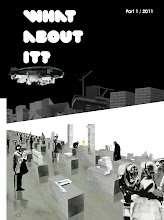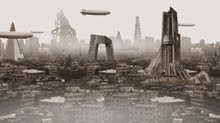
WAI’s Interview has been featured in Damdi’s latest publication Portfolio
The Interview in English as follows:
Q. Is your portfolio for your own or for an office? What is the difference between the two?
Our portfolio is for our office, WAI Architecture Think Tank. The office portfolio focuses on the particular design philosophy of WAI; in this way our first concern is to integrate theoretical texts, which we consider as a major part in our approach, as well as underlining the development of our different projects ranging from pure research, urbanism, architecture and several experimental mediums, like magazines, film and exhibition art. An individual portfolio, for somebody as young as us, would usually focus more on the diversity of approaches and experiences that you can acquire through your studies and professional practice.
Q. What is the most important element in a portfolio?
For us it can be seen as the good balance between content and layout. Too much of either of those elements can alter the harmony, and result in a portfolio too heavy in the first case, or a portfolio too banal in the second.
Q. How do you select the works to be included in the portfolio? Where does the most successful project placed within the portfolio? What is the best way to order the projects?
It all depends on the projects that you have, and what you want to communicate through the portfolio. It is common to think that the logic corresponds to a chronology, with the most recent projects or the projects that portray the best of your development in the beginning to make a good first impression.
Q. What makes a successful portfolio?
A really successful portfolio is the one that highlights your capacities. A portfolio is something very personal that should reflect the best characteristics of the author. The size, layout and colors should variate according to the preference of the author, as long as it takes into account that which is most suitable way to display his or her work.
Q. What is the most effective layout?
What can be reckon as being a clear layout would be a design that doesn't obliterates the content. The layout should help to showcase the work displayed without competing with it.
Q. Where do you get your ideas?
We are constantly reading and looking around us. We get inspiration everywhere, from graphic design websites, contemporary magazines on design and culture, to the historical research we do for theoretical projects as on the 20th century avant-garde movement in art and architecture that particularly interest us .
Q. If there is one, what is the weakness or needs of development of your portfolio? If none, how can you make the perfect portfolio?
In the name of WAI architecture, we are concerned in developing our design philosophy, and that is reflected in our portfolio. For us the most important thing is how to manage to have substance and content in what we do, and how to create a visual language that displays it. In that sense our portfolio will develop as our projects get more complex and our practice more mature.
Q. What are the most common mistakes made by people making portfolio?
A very common mistake in portfolio making is the overload of material. Editing plays a major rôle at the time of making a portfolio. Very often portfolios get too saturated with material, and sometimes even too crowded with a unrefined layout. Another issue is to avoid emphasizing too much on yourself, taking the focus away from the projects.
Q. Is there a rule in making a portfolio?
For us a portfolio is like a personal magazine; the project images, content, information, and text in our case, should be integrated harmoniously. It usually follows the same logical order as in a magazine, with a front cover, followed by a small curriculum vitae, an index or page of contents and then the projects. The colors, texts, titles and images are to the discretion of the author; we don't think there is one rule for it.
Q. When and why did you make your first portfolio?
What can be considered as our first portfolio is a magazine called « What About It? Part 1 ». The publication represented a compendium of one year of WAI's work. The challenge was how to address graphically the underlying consistency of ideas behind all the different projects, even when they varied from publication texts, to architecture and urbanism competitions, to film and exhibitions.
Q. Anything to say to those making their first portfolio? If you were in the shoes of one who is judging the portfolio, what would you look for and why?
A good portfolio should achieve two main goals: be a good visual tool, and at the same time be clear about the capacities of the author. When we are judging a portfolio, we look for a line of thoughts behind the designs and the craftsmanship of the author (i.e. model making, image making, renderings, CAD).
To see complete interview and portfolio see Damdi’s Portfolio Volume 5.
Interview Available in English and Korean
To Buy a Copy: www.damdi.co.kr/





























